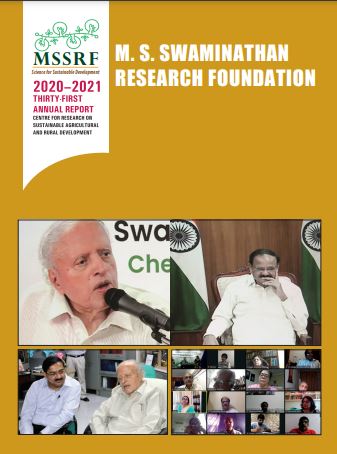People training came voluntarily to help, during Kerala floods 2018, to support their community though they had no disaster training. This spontaneous support was the saving feature of  the disaster response, finds a study.
the disaster response, finds a study.
The devastating Kerala flood 2018 was the worst incident for a century in the history of the State. The rainfall, between August 1 and 19, 2018 (164% increase), led to disastrous flooding, needing huge response to mitigate effects. The state had not witnessed such large-scale disaster and during subsequent rescue government departments faced crucial challenges in taking timely action.
The study by Joice K. Joseph et al., (MSSRF represented by Joice K. Joseph, Prajeesh Parameswaran and Anand Zacharias) investigated the awareness in vulnerability and disaster management among those who first responded during the Kerala floods 2018 and explores their disaster relief satisfaction, level of contentment with selected attributes in the flood relief operations. They were queried on satisfaction parameters from high satisfaction to high dissatisfaction on a five-point Likert scale. The parameters assessed availability of telecommunication, transportation, water, food, relief camps, involvement of social media, police/military, fishermen community, various government line departments, religious groups, and nongovernmental organizations. These are major emergency support functions for effective calamity response in the aftermath of a major disaster. The first responders, mostly fisher communities, suggest possible measures to improve community resilience. This research was primarily based on a survey conducted among coastal population (Alappuzha, Ernakulum, Kollam and Thrissur districts) who participated in flood relief operations. Data was collected from 418 respondents with pre-tested questionnaire and analyzed using SPSS software package.
The results elucidated the typical features of the community resilience from the study area which can be summarized as:
- Majority respondents disclosed involvement in group rescue operations, humanitarian sympathy and high self-satisfaction of the rescue operations.
- The first respondents were exposed to coastal disasters but had limited exposure to disaster preparedness and mock drills.
- Coastal communities can effectively utilize social capacities for disaster response.
- Primary respondents of Kerala floods-2018 were satisfied with transportation facilities, social media support, water and food supply and support from uniformed forces and Local Self Governments.
- Disaster Resilience as research in India, still lacks adequate literature.
Other issues in community resilience were absence of community-based early warning systems (CBEWS), an inadequate alliance between community and government authorities, less access to risk communication and a lack of household disaster preparedness. The study also derived suitable solutions for identified problems from global literature, as follows.
Issues in community resilience (with suggestions from global literature)
- Absence of community-based early warning systems (Develop appropriate CBEWS and ensure its timely dissemination – Lenton, 2011).
- Inadequate alliance between community and government authorities (Administrative authorities need a paradigm shift from the traditional passive response to a progressive community-based approach – Nuanchan, 2017).
- Inadequate awareness of local resources for crisis management (Detailed village resource maps and inventories are in place and their regular updation is necessary – Marshall et al., 2007).
- Less access to risk communication (Ensure access to cell phone, internet, radio, wireless, HAM, and print media along coastal belt for effective crisis communication – Reed et al., 2009).
- Insufficient response capacity among potential community services (Ensure per capita police, fire force, medical staff, shelters and volunteers – Etkin, 2016).
- Lack of household disaster preparedness (Policies that address household level approach in DRR like the CARE model need to be brought in – CARE, 2002).
- Inadequate exposure to mock drills and first aid (Emergency departments need adequate mock drills and first aid training to community as per standard guidelines – IFRC, 2015).
The study reveals that use of social capacities easily available can be activated anytime and are crucial for better community resilience in a developing country. Although hampered by limited physical and financial resources, rural societies can effectively utilize social capacities during disaster. The importance of bottoms-up approach in disaster management, comprising ‘Community-Based Disaster Risk Management’ (CBDRM) which transforms vulnerable communities to resilient communities, is to be noted. The role of people, especially fishing communities is highlighted, and shortcomings in current practices identified. The study concludes the necessity of policy integration, incorporating community strengths to reduce socio-economic impacts and vulnerabilities of natural and anthropogenic hazards.
For Future Reference:
- A comprehensive and integrated approach is required including grass-root level community as front line of disaster response.
- Community-Based Disaster Risk Management (CBDRM) potential to be tapped through training, awareness and proper early warning system.
- More research required on socio-economic dimensions of community resilience.
………………………
Joice K. Joseph, Dev Anand, P. Prajeesh, Anand Zacharias, Anu George Varghese, A. P. Pradeepkumar, and K.R. Baiju (2020). Community resilience mechanism in an unexpected extreme weather event: An analysis of the Kerala floods of 2018, India, International Journal of Disaster Risk Reduction 49, 101741.
Written by: Prajeesh Parameswaran and Joice K Joseph
Edited by: Jayashree B
Photo source
Photo 1- https://www.newindianexpress.com/states/kerala/2018/aug/22/kerala-floods…
Photo 2- https://www.indiatimes.com/news/india/fishermen-who-saved-thousands-of-l…

